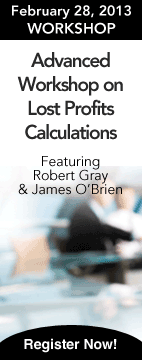
| February 6, 2013 | Issue #125-1 |
NACVA wants USPAP 2014-15 to recognize calculation engagements, consulting appraisers, and four new fact patterns The National Association of Certified Valuators and Analysts recently responded to the third exposure draft of proposed changes to the 2014-15 Uniform Standards of Professional Appraisal Practice (USPAP). In a letter to the Appraisal Practices Board, Parnell Black, president, and Robert Grossman, chair of the standards committee, target three main areas of concern:
DLOM survey ranks among top three Our most recent online survey on determining the discount for lack of marketability (DLOM) tied with last year’s survey on valuing S corps in terms of the number of respondents. (The No. 1 survey of all time: our 2011 poll on BV professional credentials.) Ranked by the depth and disparity of comments, however, the DLOM survey clearly takes the top position:
And the comments keep on coming. Valuation and litigation experts who practice in Daubert jurisdictions should reconcile their various calculation methods and support of the DLOM just as they do the result of multiple appraisal approaches/methods in their primary value conclusions, says Paul French (Lain Faulkner & Co.). “Consider the powerfulness of direct testimony when the valuation analyst says: ‘And the third way, your Honor, that I tested the reliability of my selected DLOM was …’” Given the continuing discussion and debate, we will be featuring two full-length articles on the DLOM in the next two issues of the Business Valuation Update; stay tuned for more details. Excess earnings method for determining enterprise/professional goodwill value in divorce withstands appeal The husband was one of nearly 70 partners in an anesthesiology practice who owned an equal number of shares and executed a covenant not to compete. The firm billed its services according to rates published by a trade association (the American Society of Anesthesiologists) and paid its practitioners based on their comparative units of productivity. For the two years prior to divorce, the husband’s productivity ranked between the 75th and 90th percentiles of the association’s rates. At the same time, his earnings exceeded the 90th percentile of anesthesiologists in a national survey of medical compensation (MGMA). At trial, the wife’s expert used the excess earnings approach, capitalizing the difference between the husband’s actual earnings and the industry standard, to value his interest in the anesthesiology practice at $337,000, before a discount for lack of marketability, and $253,000 after. The trial court adopted his value, and the husband appealed, arguing the expert failed to exclude personal goodwill as required by state law (Indiana). The appellate court disagreed, stating:
Read the complete digest of Burnett v. Burnett, 2012 Ind. App. Unpub. LEXIS 1477 (Nov. 13, 2012) in the next Business Valuation Update; the district court’s decision will be posted soon at BVLaw. Alerding was the expert. The Burnett case is unpublished, but it still serves as good instruction on what courts will accept as reliable evidence of valuing the goodwill of professional practices in divorce, particularly in the application of the excess earnings method by the expert—who was none other than James Alerding (Alerding Consulting). Don’t miss “The Excess Earnings Method” on February 14, when Alerding discusses the decision as well as a thorough overview of the method, its many strengths and applications, as well as its particular usefulness in determining the components of goodwill in divorce. Read all about it: What standards apply to an estate/gift tax appraisal? A recent discussion on LinkedIn’s BV Professionals group (membership required) reflects the continuing debate among appraisers—as well as some confusion—regarding the applicable standards to estate and gift tax appraisals. The original question, posed by Mark Bulmer, essentially asked whether it was necessary to certify compliance with USPAP as well as SSVS-1 when valuing an operating company in connection with estate/gift valuations. From a credentials standpoint, “the ASA is the only credentialing group that requires compliance with USPAP,” says Bob Morrison. “From the IRS's standpoint, the Pension Protection Act of 2006 (PPA) suggests that an appraisal conducted in compliance with a recognized body of appraisal standards and referencing USPAP … is more likely to meet the ‘qualified appraisal’ requirement in the PPA.” Morrison also suggests an article by Mike Crain in the Journal of Accountancy as a “good read for CPAs doing estate and gift tax appraisals,” available here. For a further comparison of SSVS-1 to USPAP and other valuation standards, James Feldman suggests “an excellent article” by Martin Lieberman and David Anderson: “Will the Real Business Valuation Standards Please Stand Up?" (CPA Journal). Another good read and analysis. After following the discussion thread, Jim Hitchner was prompted to write a thorough overview, adding his own insights and comments but astutely avoiding the “designation wars” that could plague the topic (and which leads to his referring to some of these discussions as “LinkedOut”). Read his entire analysis, currently posted at NACVA’s QuickRead. Patent value may drive return to U.S. prosperity, says new Brookings report Despite the proliferation of “patent wars” in federal courts and the perception that the system for establishing, maintaining, and measuring patent value is broken (or in need of repair), a new report from Metropolitan Policy Program (Brookings) on the current state of invention in the U.S. reveals:
The complete report, “Patenting Prosperity: Invention and Economic Performance in the United States and Its Metropolitan Areas,” is available here. Updated executive compensation survey for The 2012-2013 Northwest Executive Compensation Survey (Milliman) is now available through BVR. The survey compiles data on 19 top executive positions (CEO, CFO, COO, CIO, CTO, etc.) from over 220 privately held and publicly traded companies in Washington, Oregon, and Idaho. Various size categories include details on:
To view the first 11 pages of the survey, click here; to purchase it, click here. New resource takes the ‘mystery’ out of Monte Carlo simulations Finally, new guidance “removes the mystery surrounding Monte Carlo simulations,” writes Neil Beaton (Alvarez & Marsal) in his introduction to Monte Carlo Simulations—Advanced Techniques: A BVR Special Report. “With this report,” authors Dave Dufendach (Grant Thornton) and Jason Andrews (Alvarez & Marsal) “have taken Monte Carlo simulations out of the laboratory and into the workplace,” Beaton says. In addition to a clear explanation on how to apply Monte Carlo techniques to a broad spectrum of valuation issues, the authors address “real-life valuation problems so that even the casual practitioner will be able to understand the underlying concepts,” Beaton says. They also expose “minefields” of the Monte Carlo technique and discuss current tools to design and interpret appropriate models, all tied to the appropriate accounting rules and valuation principles. “In short, this report is invaluable for practitioners who wish to elevate their valuation analyses of complex assignments,” Beaton writes. “I highly recommend it.” New York Times puts BV in the clouds? A recent article in The New York Times, “Do You Know What Your Business Is Worth? You Should,” says the majority of small business owners delay determining the value of their enterprise until a sale is imminent—something most business appraisers are painfully aware of in their own practices. Only recently, however, have some owners started “to treat the act of valuing their business as an integral part of running it,” the article adds. That’s good for business appraisers to hear, coming from so venerable a source. But then the NYT highlights Bode Tree, a startup that created cloud software for valuing small businesses. (According to its website, the company offers “an alternative to overcomplicated and overpriced software and services currently available.”) The article also quotes a business broker who believes “there’s still something to be said for having a real person trained at valuations come in and get to know your business before running the numbers,” adding: “There’s an art to doing a valuation.” Has the article cleared or clouded the BV process for small business owners? Email your thoughts to the BVWire editor. For a short month, February is packed full of CPE On February 26, Part 2 of BVR’s Online Symposium on Healthcare Valuation continues with attorneys James Pinna and Matthew Jenkins (both Hunton & Williams) for “The Stark Law and Anti-Kickback Statute,” an important overview and update of current regulations for appraisers in the healthcare sector. On February 28, the Online Symposium on Economic Damages begins with the “Advanced Workshop on Lost Profits Calculations,” featuring Robert Gray and James O’Brien (both ParenteBeard). This intensive, four-hour workshop is free to subscribers of the full Symposium and will cover the lost profits calculation process from start to finish, using case studies and “live” examples.
To ensure this email is delivered to your inbox, please add editor@bvwire.com to your e-mail address book. We respect your online time and privacy and pledge not to abuse this medium. To unsubscribe to BVWire™ reply to this e-mail with 'REMOVE BVWire' in the subject line or use the link below. This email was sent to %%emailaddress%% Copyright © 2013 by Business Valuation Resources, LLC |
|



